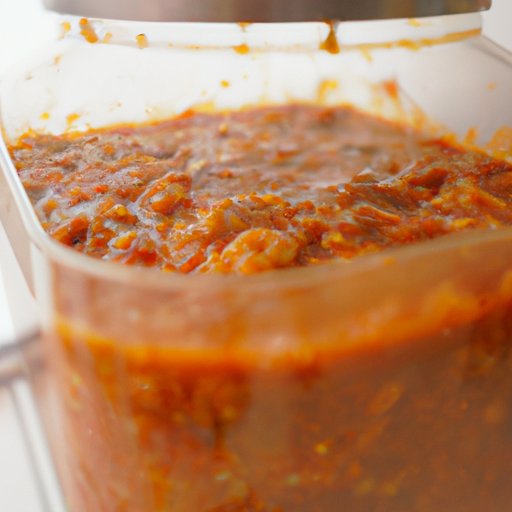
Introduction
Do you ever find yourself with too much leftover spaghetti sauce after a meal? Or maybe you have a surplus of fresh tomatoes and want to make a big batch of spaghetti sauce to store for later. Whatever the reason, freezing spaghetti sauce is a great solution to preserving it for future use. In this article, we will explore all the different aspects of freezing spaghetti sauce, including how to properly freeze and store it, tips and tricks for best results, common questions and concerns, and creative recipe ideas for using frozen spaghetti sauce.
The Ultimate Guide to Freezing Spaghetti Sauce
Freezing spaghetti sauce has many advantages, including convenience and easy meal prep. Here are some step-by-step instructions for how to freeze spaghetti sauce:
- Cool the spaghetti sauce completely before freezing. You can refrigerate it for a few hours before transferring it to the freezer.
- Use high-quality storage containers or freezer bags to prevent freezer burn and ensure the sauce stays fresh for a long time.
- Label the container or bag with the date the sauce was frozen. Spaghetti sauce can be frozen for up to six months, so it’s important to keep track of when it was frozen.
When it comes time to use the frozen spaghetti sauce, simply thaw it in the refrigerator overnight or by placing the container in cold water. Reheat the sauce in a pot on the stove or in the microwave, stirring frequently.
Preserving the Harvest: How to Freeze Fresh Spaghetti Sauce
Making spaghetti sauce with fresh tomatoes and herbs is a great way to use up a bountiful harvest from your garden or farmer’s market. Follow these tips for making and freezing fresh spaghetti sauce:
- Blanch the tomatoes by boiling them for a few minutes, then placing them in an ice water bath to remove the skins.
- Use a food processor or blender to puree the tomatoes and other ingredients. You can also strain the sauce if you prefer a smoother texture.
- Allow the sauce to cool completely before freezing, then follow the instructions for freezing and storing mentioned above.
Once you have frozen fresh spaghetti sauce, you can use it in a variety of recipes. Try it as a pizza sauce, in baked pasta dishes like lasagna, or even as a sandwich spread.
Frequently Asked Questions About Freezing Spaghetti Sauce
Here are answers to some common questions and concerns about freezing spaghetti sauce:
- How long can you freeze spaghetti sauce for? Spaghetti sauce can be frozen for up to six months.
- Does spaghetti sauce lose flavor or texture when frozen? If stored properly, frozen spaghetti sauce should taste just as good as fresh sauce when thawed and reheated.
- What is the best way to thaw frozen spaghetti sauce? The best way to thaw frozen spaghetti sauce is to let it thaw in the refrigerator overnight. You can also use the defrost setting on a microwave or thaw it in a pot on the stove.
- What are some tips for reheating frozen spaghetti sauce? Reheat the sauce in a pot on the stove or in the microwave, stirring frequently to prevent burning or sticking.
How to Batch-Cook Spaghetti Sauce and Freeze It for Later
If you want to make a big batch of spaghetti sauce to store for later, here is a recipe:
- Ingredients: 2 lbs. ground beef, 2 cans of diced tomatoes, 1 can of tomato sauce, 1 onion, chopped, 3 garlic cloves, minced, 2 tsp. dried basil, 2 tsp. dried oregano, Salt and pepper to taste.
- Directions: Brown the ground beef in a pot and add the onion and garlic. Add the diced tomatoes, tomato sauce, and spices and simmer for 30 minutes. Allow the sauce to cool completely before freezing in storage containers or bags.
You can also adapt this recipe to your personal preferences by adding other ingredients like vegetables, different spices, or even meatballs.
3 Creative Ways to Use Frozen Spaghetti Sauce
Here are three different recipe ideas for using frozen spaghetti sauce:
- Spaghetti Pie – Mix cooked spaghetti with frozen spaghetti sauce and eggs, then bake in a pie dish for a delicious twist on traditional spaghetti.
- Cheesy Spaghetti Squash – Scoop out the seeds and bake a spaghetti squash in the oven. Once it’s cooked, top it with frozen spaghetti sauce and sprinkle with cheese before broiling until melted and bubbly.
- Meatball Subs – Heat up frozen spaghetti sauce and cook up some meatballs. Layer the sauce and meatballs on a sub roll and top with melted cheese and fresh herbs.
Conclusion
Freezing spaghetti sauce is a great way to save time and money in the kitchen, and there are many different ways to make and use frozen spaghetti sauce. Remember to follow the proper steps for freezing and storing the sauce, and experiment with different recipes and techniques to create your own unique dishes.





